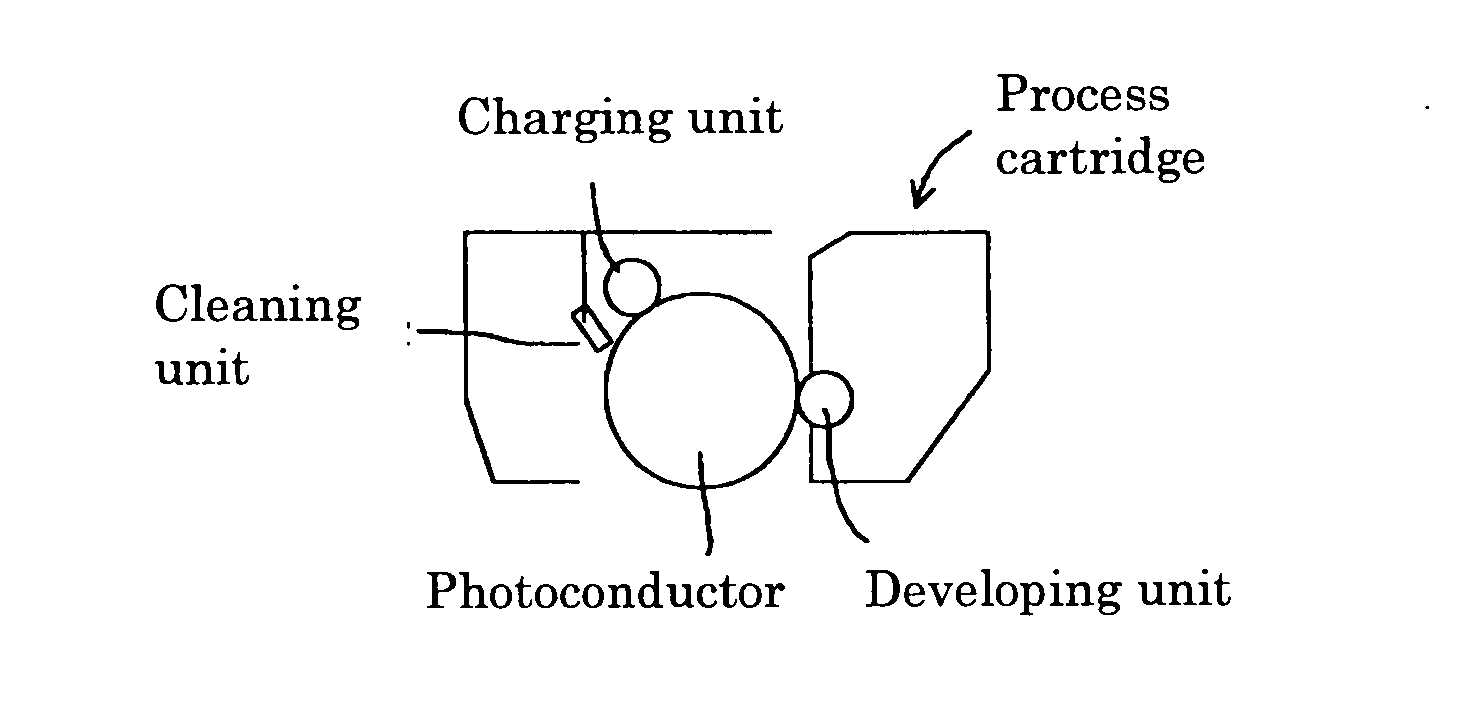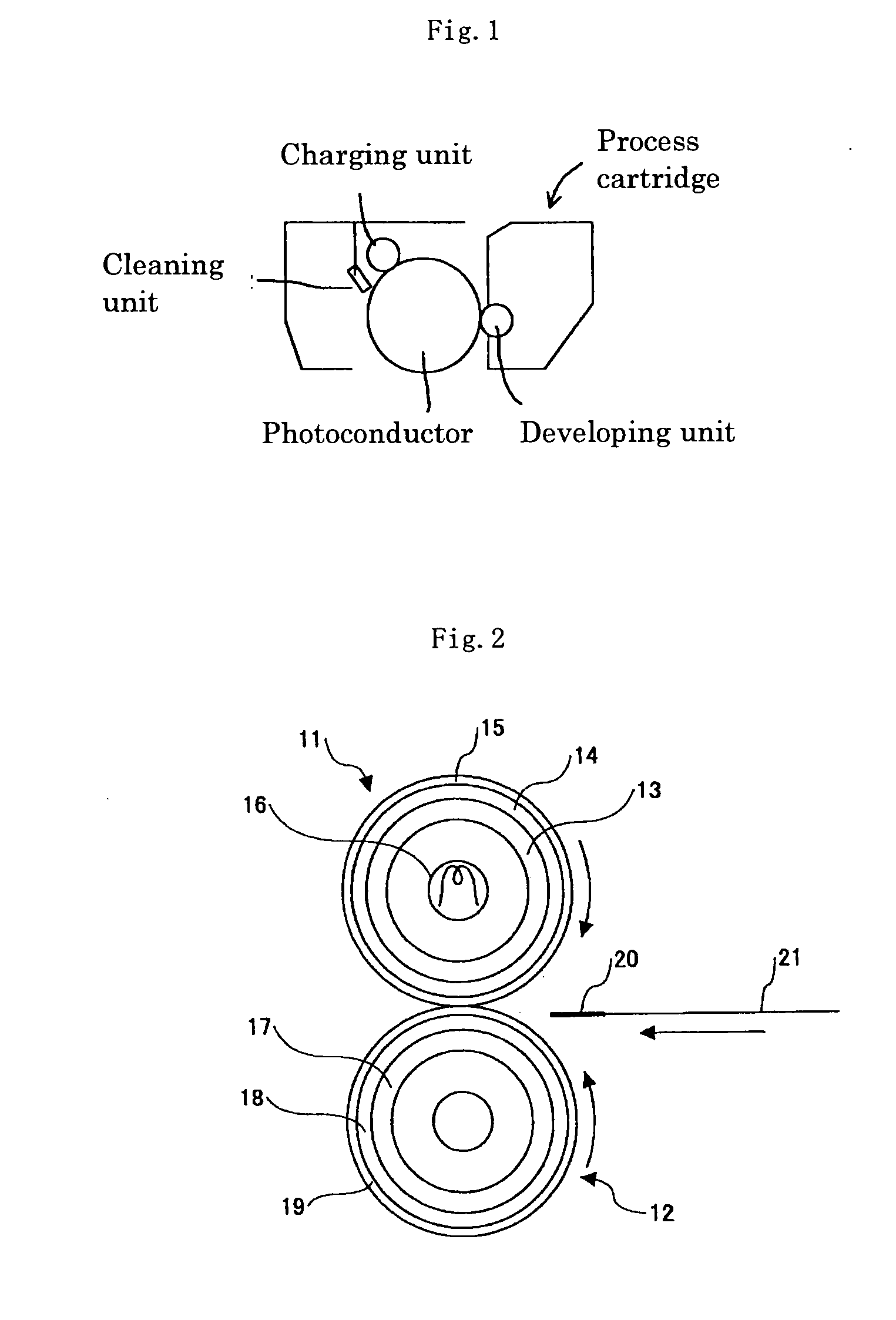Toner and method for producing the same, toner container, developer, image forming apparatus and process cartridge
a technology of toner and development method, applied in the field of non-magnetic toner, can solve the problems of difficult to transfer all of the spherical toner particles degrade the heat-resistance/storage stability of the toner, and expose the release agent to the toner surface, etc., to achieve stable charge characteristics, developability and transferability, and high quality
- Summary
- Abstract
- Description
- Claims
- Application Information
AI Technical Summary
Benefits of technology
Problems solved by technology
Method used
Image
Examples
example 1
Preparation of Dispersion Liquid
[0164]In a vessel equipped with a stirring rod and a thermometer, 96 parts of the [polyester 1], 32 parts of paraffin wax (melting point: 72° C.) and 383 parts of ethyl acetate were placed, and the reaction mixture thus obtained was increased in temperature under stirring to 80° C., maintained at 80° C. for 5 hours, and thereafter cooled down to 30° C. over a period of 1 hour. The mixture thus obtained was transferred to another vessel, and the mixture was dispersed by using a beads mill (Ultravisco mill, manufactured by Aimex Co., Ltd.) under the conditions that the liquid feeding rate was 1 kg / hr, the disk circumferential speed was 6 m / sec, 0.5-mm zirconia beads were loaded such that they make up 80% by volume of the interior or the mill, and the number of pass was three. In this way a [raw material dissolved liquid 1] was obtained. Then, 325 parts of the [raw material dissolved liquid 1] was added with 338 parts of a 70% by mass ethyl acet...
example 2
[0177]A [developer 2] of the present invention was obtained in the same manner as in Example 1 except that the fed amount of paraffin wax in the preparation of the dispersion liquid (oil phase) in Example 1 was changed to 5 parts.
[0178]The volume average particle size (Dv) and the number average particle size (Dn) of the obtained [toner base 2] were 5.4 μm and 4.9 μm, respectively, and Dv / Dn was 1.10 and the average circularity was 0.971. The peak intensity ratio R of the peak intensity derived from the Pes skeleton (bisphenol derivative) to the peak intensity derived from the releasing agent (ethylene chain), as measured ATR-IR method, was found to be 0.082.
[0179]The endothermic amounts H1 and H2 of the releasing agent included in the toner, measured by the DSC method, were found to be 6.6 (mJ / mg) and 6.4 (mJ / mg), respectively, to give a ratio of H2 / H1=0.97.
example 3
[0180]A [developer 3] of the present invention was obtained in the same manner as in Example 1 except that the releasing agent in Example 1 was replaced with paraffin wax (melting point: 68° C.). The heating temperature in the heat treatment was set at 76° C. so as to be higher by 8° C. than the melting point of the releasing agent.
[0181]The volume average particle size (Dv) and the number average particle size (Dn) of the obtained [toner base 3] were 5.7 μm and 5.1 μm, respectively, and Dv / Dn was 1.12 and the average circularity was 0.974. I The peak intensity ratio R of the peak intensity derived from the Pes skeleton (bisphenol derivative) to the peak intensity derived from the releasing agent (ethylene chain), as measured ATR-IR method, was found to be 0.038.
[0182]The endothermic amounts H1 and H2 of the releasing agent included in the toner, measured by the DSC method, were found to be 3.8 (mJ / mg) and 3.7 (mJ / mg), respectively, to give a ratio of H2 / H1=0.97.
PUM
| Property | Measurement | Unit |
|---|---|---|
| melting point | aaaaa | aaaaa |
| molar ratio | aaaaa | aaaaa |
| particle size | aaaaa | aaaaa |
Abstract
Description
Claims
Application Information
 Login to View More
Login to View More - R&D
- Intellectual Property
- Life Sciences
- Materials
- Tech Scout
- Unparalleled Data Quality
- Higher Quality Content
- 60% Fewer Hallucinations
Browse by: Latest US Patents, China's latest patents, Technical Efficacy Thesaurus, Application Domain, Technology Topic, Popular Technical Reports.
© 2025 PatSnap. All rights reserved.Legal|Privacy policy|Modern Slavery Act Transparency Statement|Sitemap|About US| Contact US: help@patsnap.com


